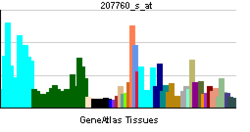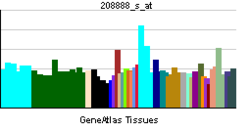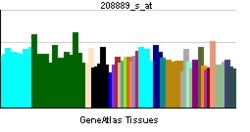- Nuclear receptor co-repressor 2
-
The nuclear receptor co-repressor 2 (NCOR2) is a transcriptional coregulatory protein that contains several nuclear receptor-interacting domains. In addition, NCOR2 appears to recruit histone deacetylases to DNA promoter regions. Hence NCOR2 assists nuclear receptors in the down regulation of target gene expression.[1][2] NCOR2 is also referred to as a silencing mediator for retinoid or thyroid-hormone receptors (SMRT)[1] or T3 receptor-associating cofactor 1 (TRAC-1).[2]
Contents
Function
NCOR2/SMRT is a transcriptional coregulatory protein that contains several modulatory functional domains including multiple autonomous repression domains as well as two or three C-terminal nuclear receptor-interacting domains.[1] NCOR2/SMRT serves as a repressive coregulatory factor (corepressor) for multiple transcription factor pathways. In this regard, NCOR2/SMRT functions as a platform protein, facilitating the recruitment of histone deacetylases to the DNA promoters bound by its interacting transcription factors.[3]
Discovery
SMRT was initially cloned and characterized in the laboratory of Dr. Ronald M. Evans at the Salk Institute for Biological Studies.[1] In another early investigation into this molecule, similar findings were reported in a variant referred to as TRAC-1.[2]
Interactions
Nuclear receptor co-repressor 2 has been shown to interact with Thyroid hormone receptor beta,[4][5][6] Retinoic acid receptor alpha,[7][8] HDAC1,[9][10] Nerve Growth factor IB,[11] Zinc finger and BTB domain-containing protein 16,[8][12][13] SIN3A,[14][15] BCL6,[13][16][17] SNW1,[18][19] Androgen receptor,[20][21][22] Peroxisome proliferator-activated receptor delta,[23] C-Fos,[24] POU2F1,[25] Histone deacetylase 5,[15] HDAC10,[9] RELA,[24][26] RBPJ,[27][28] TBL1X,[14][29][30][31] RUNX1T1,[12][32] HDAC4,[15][33] Progesterone receptor,[34] HDAC3,[10][14][29][30][31][33][35] SPEN,[36] Serum response factor,[24] C-jun,[24] Calcitriol receptor[5][37] and Promyelocytic leukemia protein.[38][39]
References
- ^ a b c d Chen JD, Evans RM (1995). "A transcriptional co-repressor that interacts with nuclear hormone receptors". Nature 377 (6548): 454–7. doi:10.1038/377454a0. PMID 7566127.
- ^ a b c Sande S, Privalsky ML (1996). "Identification of TRACs (T3 receptor-associating cofactors), a family of cofactors that associate with, and modulate the activity of, nuclear hormone receptors". Mol Endocrinol 10 (7): 813–25. doi:10.1210/me.10.7.813. PMID 8813722.
- ^ Nagy L, Kao HY, Chakravarti D, Lin RJ, Hassig CA, Ayer DE, Schreiber SL, Evans RM (1997). "Nuclear receptor repression mediated by a complex containing SMRT, mSin3A, and histone deacetylase". Cell 89 (3): 373–80. doi:10.1016/S0092-8674(00)80218-4. PMID 9150137.
- ^ Liu, Y; Takeshita A, Misiti S, Chin W W, Yen P M (Oct. 1998). "Lack of coactivator interaction can be a mechanism for dominant negative activity by mutant thyroid hormone receptors". Endocrinology (UNITED STATES) 139 (10): 4197–204. doi:10.1210/en.139.10.4197. ISSN 0013-7227. PMID 9751500.
- ^ a b Tagami, T; Lutz W H, Kumar R, Jameson J L (Dec. 1998). "The interaction of the vitamin D receptor with nuclear receptor corepressors and coactivators". Biochem. Biophys. Res. Commun. (UNITED STATES) 253 (2): 358–63. doi:10.1006/bbrc.1998.9799. ISSN 0006-291X. PMID 9878542.
- ^ Ando, S; Sarlis N J, Krishnan J, Feng X, Refetoff S, Zhang M Q, Oldfield E H, Yen P M (Sep. 2001). "Aberrant alternative splicing of thyroid hormone receptor in a TSH-secreting pituitary tumor is a mechanism for hormone resistance". Mol. Endocrinol. (United States) 15 (9): 1529–38. doi:10.1210/me.15.9.1529. ISSN 0888-8809. PMID 11518802.
- ^ Dong, Shuo; Tweardy David J (Apr. 2002). "Interactions of STAT5b-RARalpha, a novel acute promyelocytic leukemia fusion protein, with retinoic acid receptor and STAT3 signaling pathways". Blood (United States) 99 (8): 2637–46. doi:10.1182/blood.V99.8.2637. ISSN 0006-4971. PMID 11929748.
- ^ a b Hong, S H; David G, Wong C W, Dejean A, Privalsky M L (Aug. 1997). "SMRT corepressor interacts with PLZF and with the PML-retinoic acid receptor α (RARα) and PLZF-RARα oncoproteins associated with acute promyelocytic leukemia". Proc. Natl. Acad. Sci. U.S.A. (UNITED STATES) 94 (17): 9028–33. doi:10.1073/pnas.94.17.9028. ISSN 0027-8424. PMC 23013. PMID 9256429. http://www.pubmedcentral.nih.gov/articlerender.fcgi?tool=pmcentrez&artid=23013.
- ^ a b Fischer, Denise D; Cai Richard, Bhatia Umesh, Asselbergs Fred A M, Song Chuanzheng, Terry Robert, Trogani Nancy, Widmer Roland, Atadja Peter, Cohen Dalia (Feb. 2002). "Isolation and characterization of a novel class II histone deacetylase, HDAC10". J. Biol. Chem. (United States) 277 (8): 6656–66. doi:10.1074/jbc.M108055200. ISSN 0021-9258. PMID 11739383.
- ^ a b Underhill, C; Qutob M S, Yee S P, Torchia J (Dec. 2000). "A novel nuclear receptor corepressor complex, N-CoR, contains components of the mammalian SWI/SNF complex and the corepressor KAP-1". J. Biol. Chem. (UNITED STATES) 275 (51): 40463–70. doi:10.1074/jbc.M007864200. ISSN 0021-9258. PMID 11013263.
- ^ Sohn, Y C; Kwak E, Na Y, Lee J W, Lee S K (Nov. 2001). "Silencing mediator of retinoid and thyroid hormone receptors and activating signal cointegrator-2 as transcriptional coregulators of the orphan nuclear receptor Nur77". J. Biol. Chem. (United States) 276 (47): 43734–9. doi:10.1074/jbc.M107208200. ISSN 0021-9258. PMID 11559707.
- ^ a b Takahashi, Shinichiro; McConnell Melanie J, Harigae Hideo, Kaku Mitsuo, Sasaki Takeshi, Melnick Ari M, Licht Jonathan D (Jun. 2004). "The Flt3 internal tandem duplication mutant inhibits the function of transcriptional repressors by blocking interactions with SMRT". Blood (United States) 103 (12): 4650–8. doi:10.1182/blood-2003-08-2759. ISSN 0006-4971. PMID 14982881.
- ^ a b Wong, C W; Privalsky M L (Oct. 1998). "Components of the SMRT corepressor complex exhibit distinctive interactions with the POZ domain oncoproteins PLZF, PLZF-RARalpha, and BCL-6". J. Biol. Chem. (UNITED STATES) 273 (42): 27695–702. doi:10.1074/jbc.273.42.27695. ISSN 0021-9258. PMID 9765306.
- ^ a b c Li, J; Wang J, Wang J, Nawaz Z, Liu J M, Qin J, Wong J (Aug. 2000). "Both corepressor proteins SMRT and N-CoR exist in large protein complexes containing HDAC3". EMBO J. (ENGLAND) 19 (16): 4342–50. doi:10.1093/emboj/19.16.4342. ISSN 0261-4189. PMC 302030. PMID 10944117. http://www.pubmedcentral.nih.gov/articlerender.fcgi?tool=pmcentrez&artid=302030.
- ^ a b c Huang, E Y; Zhang J, Miska E A, Guenther M G, Kouzarides T, Lazar M A (Jan. 2000). "Nuclear receptor corepressors partner with class II histone deacetylases in a Sin3-independent repression pathway". Genes Dev. (UNITED STATES) 14 (1): 45–54. ISSN 0890-9369. PMC 316335. PMID 10640275. http://www.pubmedcentral.nih.gov/articlerender.fcgi?tool=pmcentrez&artid=316335.
- ^ Huynh, K D; Fischle W, Verdin E, Bardwell V J (Jul. 2000). "BCoR, a novel corepressor involved in BCL-6 repression". Genes Dev. (UNITED STATES) 14 (14): 1810–23. ISSN 0890-9369. PMC 316791. PMID 10898795. http://www.pubmedcentral.nih.gov/articlerender.fcgi?tool=pmcentrez&artid=316791.
- ^ Deltour, S; Guerardel C, Leprince D (Dec. 1999). "Recruitment of SMRT/N-CoR-mSin3A-HDAC-repressing complexes is not a general mechanism for BTB/POZ transcriptional repressors: The case of HIC-1 and γFBP-B". Proc. Natl. Acad. Sci. U.S.A. (UNITED STATES) 96 (26): 14831–6. doi:10.1073/pnas.96.26.14831. ISSN 0027-8424. PMC 24733. PMID 10611298. http://www.pubmedcentral.nih.gov/articlerender.fcgi?tool=pmcentrez&artid=24733.
- ^ Zhou, S; Fujimuro M, Hsieh J J, Chen L, Hayward S D (Feb. 2000). "A Role for SKIP in EBNA2 Activation of CBF1-Repressed Promoters". J. Virol. (UNITED STATES) 74 (4): 1939–47. doi:10.1128/JVI.74.4.1939-1947.2000. ISSN 0022-538X. PMC 111672. PMID 10644367. http://www.pubmedcentral.nih.gov/articlerender.fcgi?tool=pmcentrez&artid=111672.
- ^ Zhou, S; Fujimuro M, Hsieh J J, Chen L, Miyamoto A, Weinmaster G, Hayward S D (Apr. 2000). "SKIP, a CBF1-Associated Protein, Interacts with the Ankyrin Repeat Domain of NotchIC To Facilitate NotchIC Function". Mol. Cell. Biol. (UNITED STATES) 20 (7): 2400–10. doi:10.1128/MCB.20.7.2400-2410.2000. ISSN 0270-7306. PMC 85419. PMID 10713164. http://www.pubmedcentral.nih.gov/articlerender.fcgi?tool=pmcentrez&artid=85419.
- ^ Liao, Guoqing; Chen Liuh-Yow, Zhang Aihua, Godavarthy Aparna, Xia Fang, Ghosh Jagadish Chandra, Li Hui, Chen J Don (Feb. 2003). "Regulation of androgen receptor activity by the nuclear receptor corepressor SMRT". J. Biol. Chem. (United States) 278 (7): 5052–61. doi:10.1074/jbc.M206374200. ISSN 0021-9258. PMID 12441355.
- ^ Song, Liang-Nian; Coghlan Meghan, Gelmann Edward P (Jan. 2004). "Antiandrogen effects of mifepristone on coactivator and corepressor interactions with the androgen receptor". Mol. Endocrinol. (United States) 18 (1): 70–85. doi:10.1210/me.2003-0189. ISSN 0888-8809. PMID 14593076.
- ^ Dotzlaw, Helmut; Moehren Udo, Mink Sigrun, Cato Andrew C B, Iñiguez Lluhí Jorge A, Baniahmad Aria (Apr. 2002). "The amino terminus of the human AR is target for corepressor action and antihormone agonism". Mol. Endocrinol. (United States) 16 (4): 661–73. doi:10.1210/me.16.4.661. ISSN 0888-8809. PMID 11923464.
- ^ Shi, Yanhong; Hon Michelle, Evans Ronald M (Mar. 2002). "The peroxisome proliferator-activated receptor δ, an integrator of transcriptional repression and nuclear receptor signaling". Proc. Natl. Acad. Sci. U.S.A. (United States) 99 (5): 2613–8. doi:10.1073/pnas.052707099. ISSN 0027-8424. PMC 122396. PMID 11867749. http://www.pubmedcentral.nih.gov/articlerender.fcgi?tool=pmcentrez&artid=122396.
- ^ a b c d Lee, S K; Kim J H, Lee Y C, Cheong J, Lee J W (Apr. 2000). "Silencing mediator of retinoic acid and thyroid hormone receptors, as a novel transcriptional corepressor molecule of activating protein-1, nuclear factor-kappaB, and serum response factor". J. Biol. Chem. (UNITED STATES) 275 (17): 12470–4. doi:10.1074/jbc.275.17.12470. ISSN 0021-9258. PMID 10777532.
- ^ Kakizawa, T; Miyamoto T, Ichikawa K, Takeda T, Suzuki S, Mori J, Kumagai M, Yamashita K, Hashizume K (Mar. 2001). "Silencing mediator for retinoid and thyroid hormone receptors interacts with octamer transcription factor-1 and acts as a transcriptional repressor". J. Biol. Chem. (United States) 276 (13): 9720–5. doi:10.1074/jbc.M008531200. ISSN 0021-9258. PMID 11134019.
- ^ Espinosa, Lluís; Inglés-Esteve Julia, Robert-Moreno Alex, Bigas Anna (Feb. 2003). "IκBα and p65 Regulate the Cytoplasmic Shuttling of Nuclear Corepressors: Cross-talk between Notch and NFκB Pathways". Mol. Biol. Cell (United States) 14 (2): 491–502. doi:10.1091/mbc.E02-07-0404. ISSN 1059-1524. PMC 149987. PMID 12589049. http://www.pubmedcentral.nih.gov/articlerender.fcgi?tool=pmcentrez&artid=149987.
- ^ Beatus, P; Lundkvist J, Oberg C, Pedersen K, Lendahl U (Jun. 2001). "The origin of the ankyrin repeat region in Notch intracellular domains is critical for regulation of HES promoter activity". Mech. Dev. (Ireland) 104 (1–2): 3–20. doi:10.1016/S0925-4773(01)00373-2. ISSN 0925-4773. PMID 11404076.
- ^ Zhou, S; Hayward S D (Sep. 2001). "Nuclear Localization of CBF1 Is Regulated by Interactions with the SMRT Corepressor Complex". Mol. Cell. Biol. (United States) 21 (18): 6222–32. doi:10.1128/MCB.21.18.6222-6232.2001. ISSN 0270-7306. PMC 87339. PMID 11509665. http://www.pubmedcentral.nih.gov/articlerender.fcgi?tool=pmcentrez&artid=87339.
- ^ a b Yoon, Ho-Geun; Chan Doug W, Huang Zhi-Qing, Li Jiwen, Fondell Joseph D, Qin Jun, Wong Jiemin (Mar. 2003). "Purification and functional characterization of the human N-CoR complex: the roles of HDAC3, TBL1 and TBLR1". EMBO J. (England) 22 (6): 1336–46. doi:10.1093/emboj/cdg120. ISSN 0261-4189. PMC 151047. PMID 12628926. http://www.pubmedcentral.nih.gov/articlerender.fcgi?tool=pmcentrez&artid=151047.
- ^ a b Guenther, Matthew G; Yu Jiujiu, Kao Gary D, Yen Tim J, Lazar Mitchell A (Dec. 2002). "Assembly of the SMRT–histone deacetylase 3 repression complex requires the TCP-1 ring complex". Genes Dev. (United States) 16 (24): 3130–5. doi:10.1101/gad.1037502. ISSN 0890-9369. PMC 187500. PMID 12502735. http://www.pubmedcentral.nih.gov/articlerender.fcgi?tool=pmcentrez&artid=187500.
- ^ a b Guenther, M G; Lane W S, Fischle W, Verdin E, Lazar M A, Shiekhattar R (May. 2000). "A core SMRT corepressor complex containing HDAC3 and TBL1, a WD40-repeat protein linked to deafness". Genes Dev. (UNITED STATES) 14 (9): 1048–57. ISSN 0890-9369. PMC 316569. PMID 10809664. http://www.pubmedcentral.nih.gov/articlerender.fcgi?tool=pmcentrez&artid=316569.
- ^ Zhang, J; Hug B A, Huang E Y, Chen C W, Gelmetti V, Maccarana M, Minucci S, Pelicci P G, Lazar M A (Jan. 2001). "Oligomerization of ETO Is Obligatory for Corepressor Interaction". Mol. Cell. Biol. (UNITED STATES) 21 (1): 156–63. doi:10.1128/MCB.21.1.156-163.2001. ISSN 0270-7306. PMC 88789. PMID 11113190. http://www.pubmedcentral.nih.gov/articlerender.fcgi?tool=pmcentrez&artid=88789.
- ^ a b Fischle, Wolfgang; Dequiedt Franck, Hendzel Michael J, Guenther Matthew G, Lazar Mitchell A, Voelter Wolfgang, Verdin Eric (Jan. 2002). "Enzymatic activity associated with class II HDACs is dependent on a multiprotein complex containing HDAC3 and SMRT/N-CoR". Mol. Cell (United States) 9 (1): 45–57. doi:10.1016/S1097-2765(01)00429-4. ISSN 1097-2765. PMID 11804585.
- ^ Giangrande, P H; Kimbrel E A, Edwards D P, McDonnell D P (May. 2000). "The Opposing Transcriptional Activities of the Two Isoforms of the Human Progesterone Receptor Are Due to Differential Cofactor Binding". Mol. Cell. Biol. (UNITED STATES) 20 (9): 3102–15. doi:10.1128/MCB.20.9.3102-3115.2000. ISSN 0270-7306. PMC 85605. PMID 10757795. http://www.pubmedcentral.nih.gov/articlerender.fcgi?tool=pmcentrez&artid=85605.
- ^ Yoon, Ho-Geun; Chan Doug W, Reynolds Albert B, Qin Jun, Wong Jiemin (Sep. 2003). "N-CoR mediates DNA methylation-dependent repression through a methyl CpG binding protein Kaiso". Mol. Cell (United States) 12 (3): 723–34. doi:10.1016/j.molcel.2003.08.008. ISSN 1097-2765. PMID 14527417.
- ^ Shi, Y; Downes M, Xie W, Kao H Y, Ordentlich P, Tsai C C, Hon M, Evans R M (May. 2001). "Sharp, an inducible cofactor that integrates nuclear receptor repression and activation". Genes Dev. (United States) 15 (9): 1140–51. doi:10.1101/gad.871201. ISSN 0890-9369. PMC 312688. PMID 11331609. http://www.pubmedcentral.nih.gov/articlerender.fcgi?tool=pmcentrez&artid=312688.
- ^ Puccetti, Elena; Obradovic Darja, Beissert Tim, Bianchini Andrea, Washburn Birgit, Chiaradonna Ferdinando, Boehrer Simone, Hoelzer Dieter, Ottmann Oliver Gerhard, Pelicci Pier Giuseppe, Nervi Clara, Ruthardt Martin (Dec. 2002). "AML-associated translocation products block vitamin D(3)-induced differentiation by sequestering the vitamin D(3) receptor". Cancer Res. (United States) 62 (23): 7050–8. ISSN 0008-5472. PMID 12460926.
- ^ Khan, M M; Nomura T, Kim H, Kaul S C, Wadhwa R, Shinagawa T, Ichikawa-Iwata E, Zhong S, Pandolfi P P, Ishii S (Jun. 2001). "Role of PML and PML-RARalpha in Mad-mediated transcriptional repression". Mol. Cell (United States) 7 (6): 1233–43. doi:10.1016/S1097-2765(01)00257-X. ISSN 1097-2765. PMID 11430826.
- ^ Hong, S H; Yang Z, Privalsky M L (Nov. 2001). "Arsenic Trioxide Is a Potent Inhibitor of the Interaction of SMRT Corepressor with Its Transcription Factor Partners, Including the PML-Retinoic Acid Receptor α Oncoprotein Found in Human Acute Promyelocytic Leukemia". Mol. Cell. Biol. (United States) 21 (21): 7172–82. doi:10.1128/MCB.21.21.7172-7182.2001. ISSN 0270-7306. PMC 99892. PMID 11585900. http://www.pubmedcentral.nih.gov/articlerender.fcgi?tool=pmcentrez&artid=99892.
Further reading
- Hörlein AJ, Näär AM, Heinzel T et al. (1995). "Ligand-independent repression by the thyroid hormone receptor mediated by a nuclear receptor co-repressor". Nature 377 (6548): 397–404. doi:10.1038/377397a0. PMID 7566114.
- Chen JD, Evans RM (1995). "A transcriptional co-repressor that interacts with nuclear hormone receptors". Nature 377 (6548): 454–7. doi:10.1038/377454a0. PMID 7566127.
- Sande S, Privalsky ML (1997). "Identification of TRACs (T3 receptor-associating cofactors), a family of cofactors that associate with, and modulate the activity of, nuclear hormone receptors". Mol. Endocrinol. 10 (7): 813–25. doi:10.1210/me.10.7.813. PMID 8813722.
- Bonaldo MF, Lennon G, Soares MB (1997). "Normalization and subtraction: two approaches to facilitate gene discovery". Genome Res. 6 (9): 791–806. doi:10.1101/gr.6.9.791. PMID 8889548.
- Margolis RL, Abraham MR, Gatchell SB et al. (1997). "cDNAs with long CAG trinucleotide repeats from human brain". Hum. Genet. 100 (1): 114–22. doi:10.1007/s004390050476. PMID 9225980.
- Hong SH, David G, Wong CW et al. (1997). "SMRT corepressor interacts with PLZF and with the PML-retinoic acid receptor α (RARα) and PLZF-RARα oncoproteins associated with acute promyelocytic leukemia". Proc. Natl. Acad. Sci. U.S.A. 94 (17): 9028–33. doi:10.1073/pnas.94.17.9028. PMC 23013. PMID 9256429. http://www.pubmedcentral.nih.gov/articlerender.fcgi?tool=pmcentrez&artid=23013.
- Chen H, Lin RJ, Schiltz RL et al. (1997). "Nuclear receptor coactivator ACTR is a novel histone acetyltransferase and forms a multimeric activation complex with P/CAF and CBP/p300". Cell 90 (3): 569–80. doi:10.1016/S0092-8674(00)80516-4. PMID 9267036.
- Lin RJ, Nagy L, Inoue S et al. (1998). "Role of the histone deacetylase complex in acute promyelocytic leukaemia". Nature 391 (6669): 811–4. doi:10.1038/35895. PMID 9486654.
- Laherty CD, Billin AN, Lavinsky RM et al. (1998). "SAP30, a component of the mSin3 corepressor complex involved in N-CoR-mediated repression by specific transcription factors". Mol. Cell 2 (1): 33–42. doi:10.1016/S1097-2765(00)80111-2. PMID 9702189.
- Liu Y, Takeshita A, Misiti S et al. (1998). "Lack of coactivator interaction can be a mechanism for dominant negative activity by mutant thyroid hormone receptors". Endocrinology 139 (10): 4197–204. doi:10.1210/en.139.10.4197. PMID 9751500.
- Wong CW, Privalsky ML (1998). "Components of the SMRT corepressor complex exhibit distinctive interactions with the POZ domain oncoproteins PLZF, PLZF-RARalpha, and BCL-6". J. Biol. Chem. 273 (42): 27695–702. doi:10.1074/jbc.273.42.27695. PMID 9765306.
- Ordentlich P, Downes M, Xie W et al. (1999). "Unique forms of human and mouse nuclear receptor corepressor SMRT". Proc. Natl. Acad. Sci. U.S.A. 96 (6): 2639–44. doi:10.1073/pnas.96.6.2639. PMC 15821. PMID 10077563. http://www.pubmedcentral.nih.gov/articlerender.fcgi?tool=pmcentrez&artid=15821.
- Park EJ, Schroen DJ, Yang M et al. (1999). "SMRTe, a silencing mediator for retinoid and thyroid hormone receptors-extended isoform that is more related to the nuclear receptor corepressor". Proc. Natl. Acad. Sci. U.S.A. 96 (7): 3519–24. doi:10.1073/pnas.96.7.3519. PMC 22325. PMID 10097068. http://www.pubmedcentral.nih.gov/articlerender.fcgi?tool=pmcentrez&artid=22325.
- Nguyen TA, Hoivik D, Lee JE, Safe S (1999). "Interactions of nuclear receptor coactivator/corepressor proteins with the aryl hydrocarbon receptor complex". Arch. Biochem. Biophys. 367 (2): 250–7. doi:10.1006/abbi.1999.1282. PMID 10395741.
- Bailey P, Downes M, Lau P et al. (1999). "The nuclear receptor corepressor N-CoR regulates differentiation: N-CoR directly interacts with MyoD". Mol. Endocrinol. 13 (7): 1155–68. doi:10.1210/me.13.7.1155. PMID 10406466.
- Kao HY, Downes M, Ordentlich P, Evans RM (2000). "Isolation of a novel histone deacetylase reveals that class I and class II deacetylases promote SMRT-mediated repression". Genes Dev. 14 (1): 55–66. PMC 316336. PMID 10640276. http://www.pubmedcentral.nih.gov/articlerender.fcgi?tool=pmcentrez&artid=316336.
- Zhou S, Fujimuro M, Hsieh JJ et al. (2000). "SKIP, a CBF1-Associated Protein, Interacts with the Ankyrin Repeat Domain of NotchIC To Facilitate NotchIC Function". Mol. Cell. Biol. 20 (7): 2400–10. doi:10.1128/MCB.20.7.2400-2410.2000. PMC 85419. PMID 10713164. http://www.pubmedcentral.nih.gov/articlerender.fcgi?tool=pmcentrez&artid=85419.
- Lee SK, Kim JH, Lee YC et al. (2000). "Silencing mediator of retinoic acid and thyroid hormone receptors, as a novel transcriptional corepressor molecule of activating protein-1, nuclear factor-kappaB, and serum response factor". J. Biol. Chem. 275 (17): 12470–4. doi:10.1074/jbc.275.17.12470. PMID 10777532.
- Guenther MG, Lane WS, Fischle W et al. (2000). "A core SMRT corepressor complex containing HDAC3 and TBL1, a WD40-repeat protein linked to deafness". Genes Dev. 14 (9): 1048–57. PMC 316569. PMID 10809664. http://www.pubmedcentral.nih.gov/articlerender.fcgi?tool=pmcentrez&artid=316569.
- Grozinger CM, Schreiber SL (2000). "Regulation of histone deacetylase 4 and 5 and transcriptional activity by 14-3- 3-dependent cellular localization". Proc. Natl. Acad. Sci. U.S.A. 97 (14): 7835–40. doi:10.1073/pnas.140199597. PMC 16631. PMID 10869435. http://www.pubmedcentral.nih.gov/articlerender.fcgi?tool=pmcentrez&artid=16631.
PDB gallery Transcription coregulators Coactivators Corepressors ATP-dependent remodeling factors External links
Categories:- Human proteins
- Transcription coregulators
Wikimedia Foundation. 2010.





